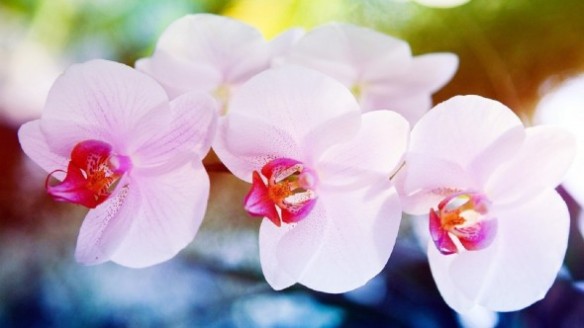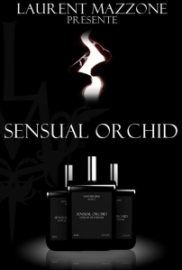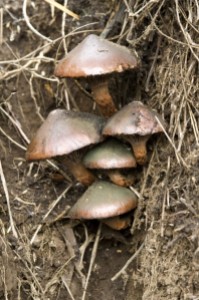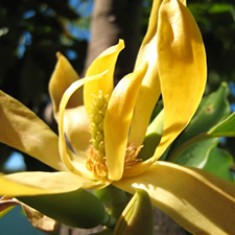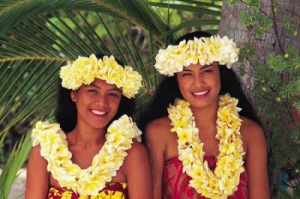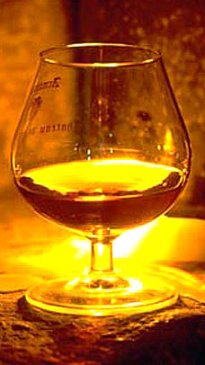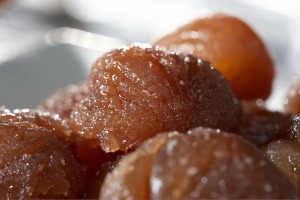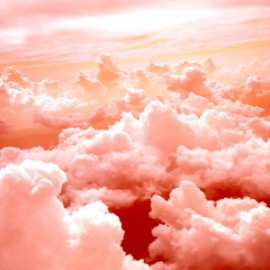Bal à Versailles… the stories and images for this benchmark animalic floriental are well-known: leather-clad chevaliers peeing in corners of Versailles; lusty courtesans whose heated, quivering bosoms trickle with musky sweat; over-ripe florals competing with the smell of unwashed knickers; and, most of all, the smell of sex in the air. Leather, civet, dark resins all swirling together with indolic orange blossoms, jasmine, rose, sweetened benzoin, Mysore sandalwood, and a plethora of other notes to recreate the smell of Versailles, a rank place where 17th century aristocrats tried to hide their unwashed flesh and carnal pursuits under a heady layer of scented, powdered florals.
That is the legend and those are the stories, but not for me. Vintage Bal à Versailles has never been the rank monster of so many adoring and horrified tales. The very polarizing — indeed, infamous — fragrance has always been about something else for me. I first smelt it when I was 6 years old, and thought it merely a lovely, heady floral with a womanly vibe and incredible glamour. The 1970s were a time of Yves Saint Laurent, Bianca Jagger, half-dressed women with clothes cut down to their navel or up to their thigh, Studio 54, or, in my neck of the woods, sleek women showing off tanned, sun-kissed Mediterranean skin in couture and diamonds at the equally wild Whiskey à Gogo and Jimmy’z nightclubs. Bal à Versailles seemed a perfect representation for the time, and certainly no different than the Opium, Fracas, or Joy on my glamourous mother’s mis à toilette table. They all epitomized sensuality and sophistication to my young mind.
We’re shaped by our childhood influences and mental associations, but I still don’t think vintage Bal à Versailles is the dangerous, rank, horrifying monster of all the tales. Honestly, it’s almost tame as compared to some of today’s animalic niche fragrances. Almost. It may be milder than Masque‘s intense Montecristo, but vintage Bal à Versailles is still not a fragrance that I’d recommend to someone just starting on their fragrance journey or to a perfumista used to modern, commercial perfumery. I wouldn’t even recommend it to more experienced perfume lovers unless they had a taste for strongly animalic, urinous, leathery, balsamic, resinous, indolic florientals with a touch of powder.
It’s a very narrow category but, for those who qualify, vintage Bal à Versailles is a must-try masterpiece that I cannot recommend enough. It is sensual, lusty but soft, sophisticated, edgy, opulent, and often verging on the feral. It is most certainly something that a man can wear. Supposedly, Michael Jackson did so for more than 30 years, stockpiling it in massive quantities. He is admittedly not a shining example of a very masculine man, but, as you will see from Basenotes and elsewhere, many men wear vintage Bal à Versailles without hesitation. One woman even said it was really a man’s fragrance, perhaps because Bal à Versailles has a leathery bent, along with a definite urinous edge from the civet that isn’t always easy. All of this, however, pertains to the vintage version, as the modern one is a ghastly, powdery, synthetic creation that has been compared to “grandmas in mothballs” and worse.
Bal à Versailles was created by Jean Desprez and released by his company with the same name in 1962. There are three vintage concentrations, but I am going to focus primarily on the lovely, very affordable, easy to obtain Eau de Cologne with a brief discussion about the stunning, more expensive Parfum. (There is also a vintage Parfum de Toilette formulation, akin to an eau de parfum, but I haven’t tried that in years, and don’t have a sample to update my memory.) I will be basing this review on my own bottle of Bal à Versailles cologne which I believe is from the 1960s, and a sample of the vintage parfum.
According to Fragrantica, Bal à Versailles’ very lengthy list of notes includes:
Top notes: rosemary, orange blossom, mandarin orange, cassia, jasmine, rose, neroli, bergamot, bulgarian rose and lemon;
Middle notes: sandalwood, patchouli, lilac, orris root, vetiver, ylang-ylang, lily-of-the-valley and leather;
Base notes: tolu balsam, amber, musk, benzoin, civet, vanilla, cedar and resins.
Bal à Versailles opens with the feral YEEOOOWL of a wild jungle cat in heat. There is no way around that simple fact, especially when you smell the fragrance up close. The word “urinous” is going to be used a hundred times in this review because that very long list of notes up top is dominated by one element above all others: civet.
If you ever want to laugh to the point of hysterical pain, I suggest you read Chandler Burr‘s account of an afternoon spent with the perfumer Jean Guichard in Givaudan smelling, among other things, civet. The incredibly amusing New York Times article entitled Meow Mix talks about what happens when civet was given on blotters to the group:
The owner of the perfume house immediately shouted, “Whoa!” The industry consultant yelled, “Ohmygod!” as if a grenade had exploded nearby. The Abercrombie woman jumped up and crouched at the door like a cornered animal. I think I actually ducked.
“This is civet!” Guichard announced. Civet is a fundamental French perfume material, a historic girder of the industry and the quintessential scent of France. It happens to come, Guichard said pleasantly, “from the anal gland of the civet cat.” [snip the truly hysterical account of the perfumer’s father, civet, “butt cream,” and kissing.] […] [¶]
Since civet is hugely powerful and long-lasting (cats use the odor to mark their territory), and since these are qualities valued by perfumers, it’s not surprising that civet is one of the fundamentals of French perfume. […][¶]
Talk to any perfumer, even American ones, and they’ll say that civet, used in tiny quantities, breathes astonishing life into perfumes, giving them weight and depth. Civet is like adding whole cream to soups or sauces: what could make you gag taken straight up and raw becomes, when underpinning the greater mix, golden and sensual.
The French can tolerate civetlike scents by the gallon. Kouros, an Yves Saint Laurent fragrance for men that’s perpetually on the best-seller list in France, is almost pure animal. It hits you like Wladimir Klitschko’s right hook and smells like his boxing shorts after 10 rounds. That is the polite way to put it. [Emphasis added by me.]
Vintage Bal à Versailles does not smell like a boxer’s dirty shorts after 10 rounds, but it does have a potent whiff of urine mixed in with honeyed orange blossoms, skanky raw leather that feels almost as if a lot of castoreum were used, and plush, warm, golden warmth. There is a strong, thick river of sticky, treacly, blackened balsams running through the base, and I would bet that one of the unnamed “resins” on the list is smoky styrax.
The intense, feral bouquet is infused with a plethora of other notes as well. Most noticeable is the bergamot that feels juicy, as if sun-sweetened and hanging thick from the vine. It is followed by crisp lemon, sweet jasmine, dewy lily of the valley, and unctuous, buttery, almost banana-like ylang-ylang. Lurking in much more quiet fashion in the background is the greenness of woody vetiver and fresh, green cedar. And, if you focus hard, you can even detect hints of rosemary flitting about, alongside a faint whisper of herbs. It’s not rosemary, per se, but more like a herbal bouquet with something almost like lavender.
Within minutes, the notes rearrange themselves and Bal à Versailles shows other facets. The jasmine surges forward in strength, followed by even more leather and musk. On their heels is bright neroli, and dried, candied oranges. There is a growing touch of roses which smell simultaneously pale and pink, but also like the dried, stale kind that you’d find pressed in a book. In the base, old-style patchouli stirs next to the resins. Its brown, spicy, and slightly smoky aroma is perfectly complemented by the tolu balsam, burnt resins, amber, and a sliver of vanilla.

Dior Couture. Photo: Patrick Demarchelier for “Dior Couture,” a book by Ingrid Sischy, Patrick Demarchelier.
From afar, Bal à Versailles smells like urinous, indolic, over-ripe, honeyed orange blossoms and sweet jasmine, infused with raw leather, juicy citrus fruits, dried roses, a wisp of smoke, and a hint of powdered vanilla sweetness, all cocooned in a musky, resinous, golden, ambered glow. It’s a skank fest that goes beyond the whiff of slightly ripe undies to something much darker. I don’t think of Marie-Antoinette at Versailles, despite the strong vibe of chevaliers dressed in leather that was pee’d upon or women in opulent ball gowns. I think of heated flesh, leather, and sex in a mix that is very modern.

Photo: Photographer: Hans Feurer. Model: Candice Swanepoel. Vogue Australia June 2013. Source: Starstyle.com
This is not grandma’s powdered flowers, not unless grandma happened to be a skanky courtesan in a ball gown with strong dominatrix tendencies. To me, Bal à Versailles feels simultaneously like something classic from the golden age of perfumery but, also, like something that could take its place amongst the niche fragrances of today with their attempts to push the boundaries and to evoke the animal within.
Few of those modern scents can possibly match the complexity of vintage Bal à Versailles. If you took parts of vintage Shalimar, threw in a good dose of Kouros‘ urinous elements, you still wouldn’t have it. One reason why is that there is far more going on with vintage Bal à Versailles than just pee. In fact, I think it is actually less urinous than either vintage Kouros (which was driven more by costus root) or Masque’s new Montecristo. While there is an animalic musk element in Bal à Versailles, I think it smells more like a civet-castoreum mix than the powerful hyrax in Montecristo, the hardcore, intense costus root note in Amouage‘s Opus VII, or the more purely musk-fur-hair combination of Parfum d’Empire‘s Musc Tonkin.
This is probably a good time to provide some contextual definitions. In my mind and to my nose, there is a definite difference between, “animalic,” “horsey,” “urinous,” “barnyard,” and “fecal” — with the progression moving from left to right in terms of intensity, rawness, and brutality. Some people use the terms interchangeably or as crude shorthand for “ass,” but that is misleading, in my opinion, and ignores the definite differences in aroma between the various elements.
In the case of vintage Bal à Versailles cologne, several of those tonalities appear on my skin, though to very different degrees. The one exception is “fecal;” that is not an issue at all. In first place is “urinous,” followed by the much milder “animalic.” The leather occasionally has the faintest touch of something “horsey,” along with the rawness of uncured hides, but both those things stem primarily from the other two elements. Once, for an incredibly brief 5 minutes, there was a suggestion of something vaguely approaching a “barnyard” tonality but it was fleeting and in the background. I have never once smelled a fecal note from Bal à Versailles. There has also never been the smell of sweat, unwashed hair, smelly armpits, or stale body odor.
Bal à Versailles is a very well-blended prismatic scent whose opening bouquet of lushly indolic flowers with urinous, animalic, raunchy, leathery, balsamic, citric, and ambered notes changes only by small degrees. The core essence of the fragrance remains largely the same until the final hours, but the nuances and the prominence of certain notes vary over time.
The vanilla and sweetness grow stronger after 15 minutes, while powder clouds loom on the horizon. Small streaks of Mysore sandalwood appear, accompanied by fresh lily of the valley, and benzoin. The latter’s cinnamon-vanilla aspect melds perfectly with the Mysore sandalwood, creating a mix that is like spicy gingerbread with a growing touch of creaminess. At times, the lemon and bergamot are quite noticeable in the background; on other occasions, the dried roses very much overpowers the jasmine in the forefront. In one test, even the lily-of-the-valley, cedar and vetiver seem quite prominent at the 90-minute mark, while the leathery darkness in the base seemed to soften substantially. The orange blossoms, however, rule them all on my skin from start to finish.
Roughly 3.25 hours into Bal à Versailles’ development, the perfume is primarily creamy orange blossoms with urinous civet, sweet jasmine, soft roses, creamy sandalwood gingerbread, and a touch of vanilla in a golden haze. The leathery balsams feel much more muted, and the perfume as a whole is sprinkled with a light dusting of powder. The latter never smells like dated, old-fashioned makeup powder on my skin, perhaps because it is thoroughly infused with benzoin sweetness and ambered warmth. Bal à Versailles now hovers just above the skin, though it is not quiet a skin scent and it is still extremely strong when sniffed up close for many more hours to come.
It takes a long time for the civet’s sharp yeowl to fade away, but the first hints of that come around the end of the 6th hour. Bal à Versailles is now dominated by creamy orange blossoms with a trace of honeyed beeswax from the sweet myrrh, followed by jasmine and lightly spiced cinnamon benzoin, all lightly dusted with powder. In its final moments, it’s merely a blur of sweet, golden florals with the vague hint of orange blossoms.
Generally, vintage Bal à Versailles cologne lasts between 10 and 11 hours on my skin, depending on the amount I apply. My bottle — like all the cologne versions — is a dab bottle, but I’ve decanted a portion into an atomizer which does increase the longevity. As a whole, the perfume is very potent in strength, but airy, lightweight, and soft in feel. The sillage is initially huge, with 2 good sprays creating an intense cloud that wafts 5-6 inches above the skin. Even when the sillage dropped at the 90-minute mark to about 2 inches, small trails would rise up from my arms whenever I moved, and linger in the air. As noted above, Bal à Versailles became a skin scent on me only at the start of the 4th hour, but it wasn’t hard to smell until the middle of the 8th hour. At that point, I was sure the perfume was about to die, but it clung to the skin tenaciously for several more hours to come. For a mere “cologne,” the longevity is excellent.
Bal à Versailles is lovely in cologne form, but it is truly spectacular in vintage parfum. It is deeper, richer, smoother, and more luxurious. There is much more leather, more darkness, and, most of the time, more raunchy brazenness. One of my few problems with the eau de cologne formulation is that civet feels quite sharp at times. That issue is overcome with the parfum, where it is much smoother and more well-rounded. I think the parfum is even more animalic than the cologne, but it’s not quite as shrieking or as obviously urinous.
There are other differences as well. On my skin, the eau de cologne is sweeter, thinner, much more overtly and obviously floral, and with a substantially weaker leather element. The vanilla comes out more in the cologne, while the darkly balsamic resins, smokiness, and ambered goldenness are stronger in the parfum. The latter has a much deeper, richer, lovelier drydown with oil-burnished, almost honeyed leather vying with the tolu balsam, incense-y styrax and amber for dominance. The florals seem almost like an afterthought at this point, which is why the parfum feels more masculine than the more feminine cologne. Yet, the parfum is also softer and has less projection on my skin, as is common with extrait versions. It lasts about an hour less than the cologne, but, then again, one generally uses much less.
I honestly cannot decide which concentration I like more. Sometimes, the sweeter, more floral, more vanillic cologne calls my name. On other occasions, the more intensely animalic parfum feels more appealing with its richer, smoother, deeper elements. Yet, sometimes, it can feel a little too animalic and a little too carnal, while the sweeter, more floral cologne seems easier to wear and more approachable. It comes down to mood, and perhaps to gender. The parfum feels a little more chevalier and opulent, while the cologne feels a little more like a feminine courtesan.
One big difference between the two is price. You can find a 1960s era bottle of the cologne on eBay for roughly $40-$60 in some pretty good sizes. There are always exceptions, with some sellers asking for much more, but it’s not hard to get a 2 oz or 60 ml (like mine) in that price range. I’ve even seen some barely touched 4 oz or 120 ml bottles go for roughly the same amount.
Unfortunately, the eBay prices for the parfum version are quite crazy for anything other than a minuscule amount. Most of the bottles offered are roughly the size of a small sample or decant: they’re frequently 2.4 ml or 0.08 oz, and some are 4 ml. The price range for those is generally between $20-$35, which isn’t terrible until you consider how little you’re getting. On occasion, you will see much larger, more conventionally sized bottles, but those come with frightening price tags to match. (There is currently an auction for 4 oz bottle of parfum starting at $875. That makes the $217 bottle of parfum in a 7.5 ml size seem almost “cheap” in comparison.) Slightly less expensive than the pure parfum is the “parfum de toilette” version, which I believe is essentially eau de parfum, though I’ve never tried it and don’t know much about it. Here are some more photos:
As a side note, there are bottles of “eau de cologne” shown on eBay which look very different than my own. They are not clear glass in a chiseled flacon, but tall, narrow bottles of opaque white with a gold pattern and, occasionally, the coloured Jean Desprez label that resembles a rococo painting of a 17th century woman. Some of the cologne bottles do resemble mine, but have a blue label instead of a cream one. I can’t date the various bottles, but I believe my bottle is the oldest version, followed by the glass one with the blue label, and then the taller, narrow, opaque white bottles which I remember from the 1970s. Here are some photos to show you the differences:
I’m no expert at all on these various versions, their dates, or how they may differ, but there is a very useful, detailed analysis provided on Bal à Versailles’ Fragrantica page by the perfume blogger, “Le Mouchoir de Monsieur.” He talks about the history of the various concentrations and reformulations, mentions their packaging differences, compares how they smell, and explains why he thinks Bal à Versailles should be dabbed on, instead of sprayed. He is clearly an expert, so I’ve included parts of his long text almost verbatim, but have broken it up with paragraph breaks to make it easier on the eyes and easier to read:
… following the classic standards of Haute Parfumerie, the original three concentrations that were initially made exhibited a trio of scents, each one different, and designed to sublimate the other two; thus, Jean Desprez himself would have instructed the wearer to splash on the Eau de Cologne with abandon, all over the body, perhaps even using it as an hair tonic. After a time, the Parfum de Toilette would be applied more sparingly, but liberally, on exposed parts of the body: The shoulders, neck, calves and decolletage. Finally, the Parfum, clearly conceived to be dabbed very sparingly on specific pulse points. […] It is my own judgement that BAV is one of the rare scents that truly does benefit from an application by hand, and not by atomizer: To atomize the parfum, for example, automatically distorts it. Remember: At the time of its launch, not one of these concentrations was offered in a vaporizer. The EDC could be then poured on, or applied with a sea sponge, as was often done with this type of “Eau,” (The first issue of this was called merely “Eau Bal a Versailles.”) The Parfum de Toilette, in its lyre shaped flacon, could be “dabbed,” eventually decanted into an atomizer and sprayed, but was most likely intended to be applied by stopper or fingertip. The original packaging of this concentration was clearly marked with the words: “A Fragrance to Compliment Bal a Versailles Parfum.” Finally, the Parfum itself, was very obviously one intended to be slapped on by fingertip with force, to awaken the veins, and to push the molecules of it into the skin.
As is rarely, if ever seen today, each one of these scents is vastly different. The EDC is a light, rosey musk and incense affair, surely the most wearbale by today’s standards, the PDT is a rich, heady symphony of smoke and resin, this one clearly the most “dated” of the three, heavy with the “Old Lady” connotations with which all of our modern noses are equipped, and finally, the Majestic Parfum, which is a symbiosis of so many elements that it defies any specific analysis in very much the same way many of the Classic Caron scents do. At the time of its advent, Bal a Versailles was the first commercial perfume of the Twentieth Century to out price “Joy,” which previously truly had been “the Costliest Perfume in the World.” […][¶]
There was a moment in time when the House of Jean Desprez, still in the hands of its founders, did itself re-formulate this composition, as it was discovered sometime around the mid to late Seventies that certain ingredients it contained were indeed toxic to the human body in the concentrations originally presented. This re-formulation was once again re-enacted in the mid Eighties, Jean Desprez still purely a French perfumer, for other reasons, these having to do with the increasing costs and outright disappearance of some of its second version components. This leaves us with seven French versions of this famed scent, all of which were of top quality, with no expense spared to maintain the integrity of the original vision of Jean Desprez[.] […][Emphasis added by me.]
Are you a little confused? Well, I wouldn’t blame you. I even skipped his detailed discussion about the more recent versions of Bal à Versailles, the two American companies that held or still hold the “Jean Desprez” name and patents from 2002 onwards, and their eau de toilette. If you’re at all curious, I encourage you to read his account. It’s a fascinating history, though convoluted and with an exhausting number of versions in total. (It seems there are fourteen, all in all.)
Suffice it to say, an expert on Bal à Versailles gives a thumbs up to the 1960s cologne as the most wearable by today’s standards, and to the vintage parfum as the truest, most beautiful embodiment of the scent. He also shares my belief that you should stay away from modern versions. I’ve heard that bottles can be found in places like TJ Maxx, and nothing good is ever said about them. People uniformly described the modern, reformulated fragrance as a horrifying, heavily powdered, very synthetic mess. I tried the modern EDT some years ago, and I wouldn’t recommend it.
If you want more information on the three, main vintage versions and how they may differ, another Fragrantica reviewer, “Loving the Alien,” offers their assessment:
The Eau de Cologne is a civet-heavy and very powdery oriental in the vein of Toujours Moi and Tabu.
The Parfum de Toilette is a caramelized amber/tolu with deep notes of rose, similar to Avon Occur!, which is clearly inspired by Bal a Versailles.
The Parfum is an intensely spicy and incensey animalic. I can think of nothing similar to the parfum version.
They are all very, very different, although they have the same amber/resin/vanilla/orange blossom theme.
The new ones vary considerably; they are not apparently related to the original scent by much.
Regardless of version, I wouldn’t recommend vintage Bal à Versailles to anyone who didn’t love animalic, skanky fragrances. Fragrantica abounds with almost as many negative reviews as admiringly positive ones, though the perfume’s entry page does not distinguish between the various versions, vintage or modern, so it’s sometimes hard to know which one struck such intense fear and revulsion in people’s hearts. Still, I cannot emphasize enough what a polarizing, terror-inducing scent Bal à Versailles can be to someone who is unaccustomed to civet, its feline yeowl, raunchiness in general, or heavy, potently indolic, vintage fragrances. Some of the descriptions range from the mere “repulsive,” to my favorite: “someone’s overactive musk leather-bound crotch.” There is also talk about cat feces, sweat, “old lady,” and mothballs (undoubtedly from the indoles).
Even those who love Bal à Versailles use terms to describe it that would be negative in many other contexts like, for example, “filthy/beautiful/sublime.” The blogger, The Perfume Dandy, wrote a review on Fragrantica under the name “Assiduosity” where he lovingly called it “bestial” and “irresistibly repugnant”:
Bal a Versailles is a dangerous, irresistibly repugnant scent for men and women prepared to dance the dance of death. For all its wondrous beauty nothing can disguise the beating of its monstrous bestial heart.
There may be flowers and powder a plenty but this is an unapologetically animal aroma with plenty of tooth and claw.
With silage the size of a herd of wildebeest and longevity the length of an elephant’s memory this is not a commitment to be taken likely.
Accept its invitation and you are bid welcome to the party of a lifetime, but stay too long and you to may succumb to the guillotine’s blade.
But hell is worth the risk!!
Honestly, I think Bal à Versailles is so much tamer than the stream of forceful, intense, alarming descriptions on Fragrantica would lead you to believe. It is not for everyone and may smell dated by some modern standards, but there are far more intensely animalic fragrances out there, in my opinion. If you can wear Montecristo, Opus VII, vintage Kouros, Hard Leather, Serge Lutens’ Muscs Koublai Khan, or Cuir Mauresque, and if you don’t mind a light dusting of benzoin powder added to their debauched skankiness, then you should have no problems with Bal à Versailles. Everyone else, however, beware.
Vintage Bal à Versailles is not only for women. One Basenotes thread entitled “Can a man wear Bal a Versailles” had numerous men chiming in enthusiastically about the scent, including Mark Behnke of Colognoisseur. For one chap, Mike Perez, the vintage Eau de Cologne had a similar feel to some famous leather fragrances:
I finally found some vintage EdC today and bought it for a great price.
The EdC has, as a few other threads suggest, a similar leather feel to Knize Ten and (dare-I-say) Tabac Blond.
I think the comparisons to L’ Air de Rein by Miller Harris are credible, although this one hints at a much more orientalized feel. [Emphasis to names added by me.]
I can definitely see why he’d mention Knize Ten, though I personally don’t find it to be animalic. I think a closer analogy might be to an animalic version of Knize Ten Golden.

The eau de toilette bottle, which looks like a larger size of the parfum, so be careful and check the concentration on the boxes. Source: Basenotes
In that same thread, another chap compares the non-cologne formulations, and echoes the very common refrain that the EDT is the least appealing of the lot, though it is unclear to me if he’s talking about vintage versions:
I currently have the Parfum de Toilette and EdT. The Edt is kinda ho-hum to me. The Pdt is much better (richer and darker) but the parfum is my favorite. I went through a tiny bottle of the parfum in no time. It’s has a vague kinship to Kouros, but much more wearable. [Emphasis to name added by me.]
The bottom line to all this is that vintage Bal à Versailles is a legendary masterpiece in its genre. It is not for everyone, but if you have any love for raunchy, animalic, heady, powerhouse orientals, then it is something that you should try at least once in your life. I think it is beautiful.


















































